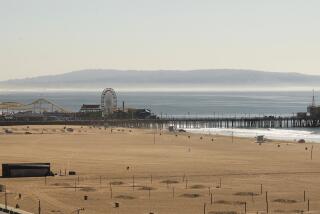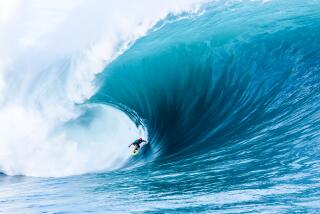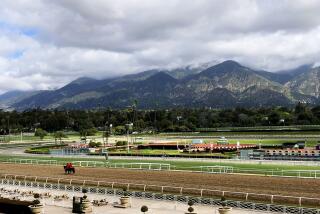War of Winds : Hawaiian Proponents Under Full Sail to Land America’s Cup Defense
- Share via
Wind, sea and sand are to Hawaii what steel is to Pittsburgh, wheat is to Kansas and cars are to Detroit: the building blocks of an economy.
Hawaii’s well-touted natural elements have made tourism the state’s No. 1 industry, a magnet that last year drew 5.6 million people, or more than five times Hawaii’s population of 1 million.
And the state wants more visitors, and the money they bring.
That is one reason why it is making an all-out effort to attract sport’s newest mega event, the America’s Cup. In the process, the state has emerged as San Diego’s most formidable competitor, at least in the view of many in the international sailing community.
To wrest the regatta from San Diego--whose hometown connections and allegiances make it the front runner--Hawaii is again relying on one of its natural components, wind.
“Obviously, because of hometown ties, San Diego has to be given serious consideration,” Hawaii Gov. John Waihee said. “But if the decision is left to sportsmen and yachtsmen--and I think the members of the San Diego Yacht Club are sportsmen first--then in the final analysis, you have to go to where the sailing conditions are best, that’s Hawaii. We can offer an exciting race.”
That’s exciting as in the recent America’s Cup races in Fremantle, where, although Dennis Conner routed the opposition in often lopsided contests, roller coaster waves, high winds, blue skies and warm weather provided a dramatic stage that introduced yacht racing to a new international television audience and lifted the sport to unprecedented popularity.
If that level of excitement is to be duplicated, Hawaii’s supporters say, then the next race four years from now must be held where conditions most closely resemble those on the Indian Ocean. And that place, they say, is Hawaii.
“Let’s face it,” says Fred Smales, chairman of the governor’s America’s Cup Committee, describing San Diego’s comparatively light winds, “what happens if a 3-hour event becomes a 4 1/2-hour event on television? Who is going to watch the next day?”
San Diego partisans counter that with boats redesigned for light air and a race course with more turns, an America’s Cup regatta off San Diego could be an exciting event, even though the area lacks consistently strong winds and large swells.
It’s very difficult at this point, though, to know how the two sites compare because the San Diego Yacht Club and the Sail America syndicate, which sponsored Conner, have yet to appoint a site-selection committee and may not do so for several more weeks. Even after a committee is chosen, it may take as long as six months to select a location.
That hasn’t stopped Hawaii, however, from moving forward. It has formed a cup committee, which is in the initial stages of putting together a proposal to be presented to the site-selection panel.
The cup committee appointed by the governor is a Who’s Who of Hawaii’s top business leaders. It is similar in this regard to San Diego’s cup committee, which includes some of the city’s best-known business people.
Hawaii’s panel includes John Couch, president and chief executive officer of Alexander & Baldwin Inc., a conglomerate that owns, among other things, Matson ship lines; Henry A. Walker Jr., chairman of the board of Amfac Inc., and Christopher B. Hemmeter, founder of one of the largest hotel development companies in Hawaii.
Like its counterpart in San Diego, the committee is just starting to identify what it has to do to entice the race to Hawaii.
As for financing, it is counting on an initial $100,000 from the state to pay for start-up expenses and studies. Committees in both houses of Hawaii’s Legislature--which held hearings on the expenditure--have approved spending the money. The matter is now before both houses for final approval.
Additionally, another bill is pending to allocate $2 million for preliminary engineering of facilities, primarily dock space, that would be needed by the 20 or so syndicates expected at the next regatta.
And the Legislature also has approved a non-binding resolution saying it would be willing to spend up to $30 million for facilities if Hawaii is selected as the defense site.
Among the enticements is a promise by the governor’s cup committee to build the San Diego Yacht Club a clubhouse in Hawaii from which it would administer the race.
“We don’t want to compete with the San Diego Yacht Club in running the event. We want to make it easy for them,” said Smales, retired chairman of the Hawaiian Cement Co. and staff commodore of the Waikiki Yacht Club.
Various dockside locations to house syndicates are being evaluated, but the leading candidate appears to be Sand Island, a spit of land across the harbor from downtown Honolulu once used as a sea plane landing area. It’s estimated that providing facilities here would cost the state about $8.5 million, maybe more depending on what the syndicates are required to provide.
The America’s Cup races would be held a few miles offshore from Honolulu in an area of consistent 18- to 20-knot winds. This is the same general vicinity where Conner and his Stars & Stripes crew trained for 10 months before their arrival in Fremantle.
There is also the feeling in Hawaii that television would prefer to have the event off Honolulu because sailing conditions would make for more-compelling telecasts and scheduling would provide for prime time broadcasting on the East Coast.
Those in television, however, such as officials for ESPN, say it’s not that simple. Though the recent America’s Cup was popular in the East, despite coming on at midnight, it also faced very little competition.
“Would that still hold if it was in prime time competing for interest with say a Big 10 basketball game?” Chris LaPlaca, spokesman for ESPN, asked.
When it comes to America’s Cup facilities, there seems to be little difference between San Diego and Hawaii. Both communities are essentially starting from scratch and vow to do what is necessary to accommodate the teams.
One area where Hawaii’s supporters acknowledge that San Diego has an advantage is in community support, defined as hometown allegiance, loyalty and support.
“They have to be considered the substantial favorite,” said Stanley Thornton, chairman of the Waikiki Yacht Club’s America’s Cup committee who also serves on the governor’s panel. “It’s their race, and they call the shots. I don’t think we can overlook that.”
But, Thornton says, there is also pressure on the San Diego Yacht Club to “put on a great event . . . to continue it as a major sailing event, a major media event.”
And that brings everything back to the wind, Hawaii’s major selling point.
Thornton says that in his discussions with Malin Burnham, president of Sail America, three primary considerations in deciding on a defense location will be support facilities, community support and sailing conditions.
In a recent letter to Thornton, Burnham said, “It is my personal opinion that if the venue is not to be in San Diego it would be because strong wind conditions are desirable . . . in this regard, I believe Hawaii would (be) head and shoulders above all the others.”
Couch, the company president who sits on the governor’s panel, said, “There’s no question that the major part of our pitch is the weather, followed by support facilities. Sailing conditions here are ideal year around. That’s something that, in the best interests of sailing and the yacht club, can’t be overlooked.”
Couch believes, as do others in Hawaii, that Conner and Burnham have divided feelings between San Diego and Hawaii. They like sailing in Hawaii and have a connection to the state because Conner trained there, yet they have strong hometown ties to San Diego.
“I’m sure they have some conflicting emotional feelings,” he said.
Though potentially hundreds of millions of dollars generated by syndicates and tourists is at stake, Smales said Hawaii is not interested in entering a bidding war with San Diego. “San Diego wants to keep it for the same reason we want it,” he said, noting that money, prestige and image are among the benefits to be received by the community chosen to be host for the defense.
“I’d say it’s a long shot (for Hawaii), but the risk-reward ratio is such,” Smales said, “we should give it our best shot.”
More to Read
Sign up for The Wild
We’ll help you find the best places to hike, bike and run, as well as the perfect silent spots for meditation and yoga.
You may occasionally receive promotional content from the Los Angeles Times.






